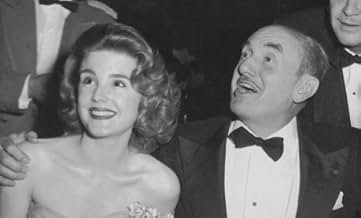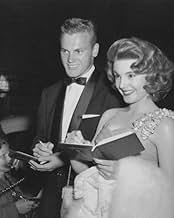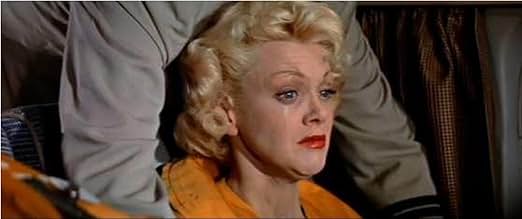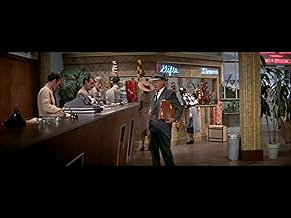IMDb रेटिंग
6.6/10
6.9 हज़ार
आपकी रेटिंग
जब एक व्यावसायिक एयरलाइन एक ट्रांस-पैसिफिक उड़ान पर इंजन की समस्याओं से जूझती है और पायलट अपना आपा खो बैठता है, तो विमान को सुरक्षित रूप से उतारने के लिए अकुशल सह-पायलट डैन रोमन जिम्मेदार हो... सभी पढ़ेंजब एक व्यावसायिक एयरलाइन एक ट्रांस-पैसिफिक उड़ान पर इंजन की समस्याओं से जूझती है और पायलट अपना आपा खो बैठता है, तो विमान को सुरक्षित रूप से उतारने के लिए अकुशल सह-पायलट डैन रोमन जिम्मेदार होता है.जब एक व्यावसायिक एयरलाइन एक ट्रांस-पैसिफिक उड़ान पर इंजन की समस्याओं से जूझती है और पायलट अपना आपा खो बैठता है, तो विमान को सुरक्षित रूप से उतारने के लिए अकुशल सह-पायलट डैन रोमन जिम्मेदार होता है.
- 1 ऑस्कर जीते
- 5 जीत और कुल 7 नामांकन
Pedro Gonzalez Gonzalez
- Gonzales
- (as Gonzalez Gonzalez)
फ़ीचर्ड समीक्षाएं
I saw The High and the Mighty when I was 16 in a theater when it first came out. Every woman walked out in love with John Wayne and every man wanted to BE John Wayne. We all hummed, whistled or la-la-la'd the theme song all the way home.
I would love to add The High and the Mighty to my collection of John Wayne films, but the Wayne Family Trust has got to allow this film to be converted to either a DVD or a VHS format. I know they are waiting for the time when they can squeeze the maximum number of dollars out of it, but if they aren't careful, they will wait too long and the world will have moved so far beyond the ideas, concepts and technology of the 50's that the film will not appeal to the younger generation of purchasers of movies.
It's more than just Wayne's performance that is being withheld from the public. I am also a great admirer of the work of the great British actor, Robert Newton and he turned in a marvelous performance here. So did Jan Sterling, Claire Trevor, Paul Fix, Lorraine Day and all the rest of the cast. Their fans deserve to see these actors in this film too. The only actor I could live without is Robert Stack. He has never done a thing for me. But the film as a whole is wonderful and should be released...ASAP
I would love to add The High and the Mighty to my collection of John Wayne films, but the Wayne Family Trust has got to allow this film to be converted to either a DVD or a VHS format. I know they are waiting for the time when they can squeeze the maximum number of dollars out of it, but if they aren't careful, they will wait too long and the world will have moved so far beyond the ideas, concepts and technology of the 50's that the film will not appeal to the younger generation of purchasers of movies.
It's more than just Wayne's performance that is being withheld from the public. I am also a great admirer of the work of the great British actor, Robert Newton and he turned in a marvelous performance here. So did Jan Sterling, Claire Trevor, Paul Fix, Lorraine Day and all the rest of the cast. Their fans deserve to see these actors in this film too. The only actor I could live without is Robert Stack. He has never done a thing for me. But the film as a whole is wonderful and should be released...ASAP
Has there ever been a more majestic film score? Slightly melancholy and beautifully haunting, Dimitri Tiomkin's Academy Award winning music gives us a grand and expansive auditory experience comparable perhaps to what a soaring eagle must feel, in its own way, as it glides high above a landscape of the mundane and the mediocre.
In the early 50s, people were just getting used to the idea that they could climb aboard a big man-made eagle and soar above cars, buses, and trains. It was a thrilling, but scary, idea, not unlike traveling on the Titanic. And so, with "The High And The Mighty", Hollywood created the first big budget movie that conveyed the idea of risk, in commercial air travel. Throughout the film, the overriding emotion is insecurity, not only among passengers but among the crew as well. Since the film was a cinematic prototype, I can see how its nerve-wracking story would appeal to moviegoers of that era. The film's angelic theme music thus provided inspiration to help viewers overcome their fear of something new and different, something potentially life threatening.
Since the early 50s, air travel has lost its sense of adventure. The film to us seems quaint and dated. What seemed odd to me, for example, was the ticket counter. The pace was leisurely, and the attention was very personal. Then, on board the plane, the stewardess made sure that the passengers got personalized attention. At one point, even the captain, upon request, reassured a nervous passenger. Those were the days.
First time viewers also need to be aware that this film is talky and dreamily melodramatic. The emphasis is on story and acting, not special effects or high-powered action. And then there is that final Act. It is different perhaps from what most of us probably would expect. But again, we must take into account the era in which the film was made.
Fifty years after its release, "The High And The Mighty", as a film, cannot compete with its own theme music. The sweeping orchestration, like music generally, transcends time and spans the generations. By contrast, technology, and mankind's reaction to technology, changes. The film's story thus has a different meaning to us than it did to the original moviegoers. If you can place the film in its proper historic context, you have a better chance of appreciating the film for what it was then, not for what it is now.
In the early 50s, people were just getting used to the idea that they could climb aboard a big man-made eagle and soar above cars, buses, and trains. It was a thrilling, but scary, idea, not unlike traveling on the Titanic. And so, with "The High And The Mighty", Hollywood created the first big budget movie that conveyed the idea of risk, in commercial air travel. Throughout the film, the overriding emotion is insecurity, not only among passengers but among the crew as well. Since the film was a cinematic prototype, I can see how its nerve-wracking story would appeal to moviegoers of that era. The film's angelic theme music thus provided inspiration to help viewers overcome their fear of something new and different, something potentially life threatening.
Since the early 50s, air travel has lost its sense of adventure. The film to us seems quaint and dated. What seemed odd to me, for example, was the ticket counter. The pace was leisurely, and the attention was very personal. Then, on board the plane, the stewardess made sure that the passengers got personalized attention. At one point, even the captain, upon request, reassured a nervous passenger. Those were the days.
First time viewers also need to be aware that this film is talky and dreamily melodramatic. The emphasis is on story and acting, not special effects or high-powered action. And then there is that final Act. It is different perhaps from what most of us probably would expect. But again, we must take into account the era in which the film was made.
Fifty years after its release, "The High And The Mighty", as a film, cannot compete with its own theme music. The sweeping orchestration, like music generally, transcends time and spans the generations. By contrast, technology, and mankind's reaction to technology, changes. The film's story thus has a different meaning to us than it did to the original moviegoers. If you can place the film in its proper historic context, you have a better chance of appreciating the film for what it was then, not for what it is now.
Probably the most popular film that has never been released to any video medium, The High and the Mighty is th4e granddaddy of all of those disaster pictures that became popular in the 70s, but they do not hold a candle to this one.
The Wayne Family in general, and I would assume sons Michael and Patrick in particular, own the film along with some others. One has to wonder why they do not release it. I have a copy I recorded from HBO many years ago and when aired it was a great print. I am fortunate to be able to see it now and then at my own leisure.
The plot of a crippled airliner in the middle of the Pacific doesn't accurately describe this film. It is a true character study with some of the finest actors of the day on hand delivering brilliant performances. Those that stand out include Jan Sterling (oscar nominee and Golden Globe winner), Claire Trevor (Oscar nominated), Phil Harris, Robert Newton, and David Brian. But each and every one in the rest of the cast can take a bow for a job well done. And That includes Wayne himself. His Dan Roman is complete, a man with strengths and weaknesses, but a man who eventually is the only one to step up in a time of crisis. It is one of his best performances.
William Wellman's direction keeps the film moving, Dimitri Tiomkin's Oscar winning score had viewers whistling along with Whistling Dan.
Mike and Pat, please let this one out before it becomes an antique. A new generation of your father's fans await this classic. It is not fair to deny them their chance to see him. And by the way. John Wayne was not the original choice to play Dan Roman. When He acquired the rights to the film he just wanted to produce it ( a la Bullfighter and the Lady). His choice wanted to play the role, but schedule conflicts prevented this, thus John Wayne had to play the role he offered to Spencer Tracy
The Wayne Family in general, and I would assume sons Michael and Patrick in particular, own the film along with some others. One has to wonder why they do not release it. I have a copy I recorded from HBO many years ago and when aired it was a great print. I am fortunate to be able to see it now and then at my own leisure.
The plot of a crippled airliner in the middle of the Pacific doesn't accurately describe this film. It is a true character study with some of the finest actors of the day on hand delivering brilliant performances. Those that stand out include Jan Sterling (oscar nominee and Golden Globe winner), Claire Trevor (Oscar nominated), Phil Harris, Robert Newton, and David Brian. But each and every one in the rest of the cast can take a bow for a job well done. And That includes Wayne himself. His Dan Roman is complete, a man with strengths and weaknesses, but a man who eventually is the only one to step up in a time of crisis. It is one of his best performances.
William Wellman's direction keeps the film moving, Dimitri Tiomkin's Oscar winning score had viewers whistling along with Whistling Dan.
Mike and Pat, please let this one out before it becomes an antique. A new generation of your father's fans await this classic. It is not fair to deny them their chance to see him. And by the way. John Wayne was not the original choice to play Dan Roman. When He acquired the rights to the film he just wanted to produce it ( a la Bullfighter and the Lady). His choice wanted to play the role, but schedule conflicts prevented this, thus John Wayne had to play the role he offered to Spencer Tracy
Trans Ocean Pacific's flight from Honolulu to San Francisco seems to proceed with no problems until one of the four engines catches fire midway on the flight which causes one of the gas tanks to leak. The crew tries to prepare to land the plane in the bay to be rescued, while experienced co-pilot Dan Roman conserve the remaining fuel to get the plane to land in the San Francisco Airport. The widely heterogeneous group of passengers which include a disgruntled man who believes his wife had an affair with one of the other passengers, a female who is hoping her man will love her despite her age, a couple on the brink of divorce, and others have to make the best of their situation and hope its not the last moments they will spend alive. Very good film that took forever to get to DVD, but seems to be worth it. Excellent performances by all and Tiomkin's score is excellent and so memorable you'll be whistling or humming it for days. The film (like many air disaster epics) seems to run a bit too long, but there is a lot of emotion to be played out here. Rating 8.
Several younger reviewers, posing as critics, have projected their post-1994 angst onto "The High and the Mighty". They have tried to make its virtues into defects I suggest because they have failed to understand the normative, non-surreal self-responsibility requirements that individuals in the 1950s tacitly accepted as their price for exercising U.S. rights under regulation. They also do not understand apparently that this flight was being undertaken as a very-long flight, and barely seven years after the end of WWII. One complained that there was talk of disaster from the beginning; I found none except some fear on the part of one neurotic passenger. And there is something else that needs to be said about the film. It was directed by William Wellman, aviation's greatest champion in Hollywood history. That may be one reason why the resulting film is in my judgment the most realistic portrayal of a 1950s airport, airplane crew, airplane flight and airplane disaster-near disaster film in history--to this day... I flew on prop planes in 1950; this is the real thing. As for the emotional belief that it is "corny', its script telegraphs some of its punches concerning passengers' ideas, but only the surreal philosophy of statist-postmodernist thinkers could see in this beautifully- thought-out film as anything but what most viewers believe it to be--the very entertaining fictional account of a distrusted loner saving an entire planeload of interesting passengers from a physical disaster to whose impending happening each reacts in his own individual way. The film opens at Honolulu Airport as flight 420 is being readied for takeoff. A succession of passengers come to the desk manned by an airline official and the flight's stewardess; so the viewer is thus cleverly allowed to discover a good bit about each one at the same time as do the refreshingly judgmental pair of officers. At the same time, we are told the story of nice-guy Dan Roman, played by John Wayne; he was the pilot of a plane that once ran into wind shear; the rear of that plane was destroyed; on impact.; he survived the death of his wife and son to fly again. The list of those aboard is long and fascinating. In addition to cynical young crewman William Campbell, uxorious navigator Wally Brown, up-tight young Robert Stack and Wayne, we meet Sidney Blackmer, overwrought and insistent; ebullient Phil Harris and his wife Ann Doran, sensible and prolific Johna Qualen, intelligent Claire Trevor, Jan Sterling as an aging beauty queen worried about meeting her new mail-contact fiancée, handsome couple John Smith and Karen Sharpe as newlyweds, Paul Fix who is elderly and unflappable, Dorothy Chen, John Howard, flight-fearing Robert Newton and his loyal wife lovely Julie Bishop, secret-keeping Paul Kelly and dynamic David Brian, and a little boy, among others. The story develops as the great airplane shudders in mid-air; gradually a crisis develops with an engine losing power. Then it is hit by a bullet, and a fire disables it and must be extinguished. The exact number of gallons of high-octane fuel aboard then becomes critical. The threat of a disaster is told in five parts--the inception; examinations and worsenings; the potential of having to ditch is faced; Wayne forces Stack to try for the coast instead of ditching; and the final climax plays out as the onshore wind gives them their last chance to make one try at the runway--with ultimately only 30 gallons of fuel left. As the potential problem develops, the passengers and crew must deal with the film's plot-theme--"taking charge of one's own life"; one man pulls a gun on the man he suspects of having made love to his wife; others have to be stopped from screaming, others face issues long put aside, others express regrets, hopes or fears; others demand or ask for information; and the crew face their own problems as well. Uniting the whole taut drama is the towering experience, calm and underplaying by Wayne and the thin-voice maturity, intelligence and normalcy of Doe Avedon as the chief stewardess. The other unusual feature of the film is Wellman's use of extended flashbacks for a number of persons, which is a feature that indicates to viewers information as well as passage of time. Here it is used in several innovative ways-to indicate character, to reinforce dramatic points and to strengthen the presentation of values such as a nuclear scientist's reasons for quitting his job, etc. The script for the novel was written by the author of the original novel "The High and the Mighty", aviation fiction expert Ernest K. Gann. The cinematography was done by Archie J. Stout, and the music which uses Wayne whistling the main theme among other presentations was done by Dimitri Tiomkin, co-author of the famous and popular title song, which was a hit both with and without lyrics. Among the solid cast also one should note Regis Toomey, Laraine Day, Douglas Kennedy, and Gonzales Gonzales. Among the main characters, Wayne, David Brian, Sindey Blackmer, Claire Trevor, John Howard, Julie Bishop, Robert Newton, Phil Harris, John Qualen and Robert Stack all do standout work. The scene where luggage is jettisoned to lighten the plane, the gradual revelation of the aircraft's problems, the dialogue sequences and the entire atmosphere of the film--as well as the gripping climactic approach to San Francisco--are all memorable.achievements in my view. Watch for Wayne's explanation that they will probably have to ditch, addressed to all the passengers. This is a nearly-great and unarguably a deservedly popular film.
क्या आपको पता है
- ट्रिवियाErnest Gann's novel clearly indicates that the character of Sally McKee has resorted to prostitution in order to survive. The film version, made at the height of Hollywood censorship, was unable to explicitly state this; however, Gann slyly managed to insinuate the information during Sally's entrance, wherein two sailors at the Honolulu airport recognize her and pointedly remark, "Hey, look! Remember?"
- गूफ़Near the end of the film, Air Traffic Control clears the aircraft to land on "runway 39" This is impossible. Runways are numbered are within 10 degrees of their actual magnetic heading, and since there are only 360 degrees on the compass, the highest runway number possible is "runway 36".
- भाव
Alsop: She may be put together with paste and flour, but that woman has something. What would you say it was?
Miss Spalding: Practice. Plenty of practice.
- इसके अलावा अन्य वर्जनThe song "The High and the Mighty" (with lyrics) does not appear in the original 1954 release of this film. However, the studio wanted the hugely popular, chart-topping song to be nominated for the Best Song Academy Award that year. According to AMPAS regulations, the song could not be nominated because it was no officially sung in the film, even if would be heard elsewhere. To satisfy these regulations, a version was released towards the tail-end of 1954 for a few nights only with the song inserted into an Exit Music. The Academy then decided to give the song a nomination on the basis of these screenings. The song lost to "Three Coins in a Fountain".
- कनेक्शनEdited into The FBI Story (1959)
टॉप पसंद
रेटिंग देने के लिए साइन-इन करें और वैयक्तिकृत सुझावों के लिए वॉचलिस्ट करें
- How long is The High and the Mighty?Alexa द्वारा संचालित
विवरण
- रिलीज़ की तारीख़
- कंट्री ऑफ़ ओरिजिन
- भाषा
- इस रूप में भी जाना जाता है
- William A. Wellman's The High and the Mighty
- फ़िल्माने की जगहें
- उत्पादन कंपनी
- IMDbPro पर और कंपनी क्रेडिट देखें
बॉक्स ऑफ़िस
- बजट
- $14,70,000(अनुमानित)
- दुनिया भर में सकल
- $4,334
- चलने की अवधि2 घंटे 27 मिनट
- ध्वनि मिश्रण
- पक्ष अनुपात
- 2.55 : 1
इस पेज में योगदान दें
किसी बदलाव का सुझाव दें या अनुपलब्ध कॉन्टेंट जोड़ें








































